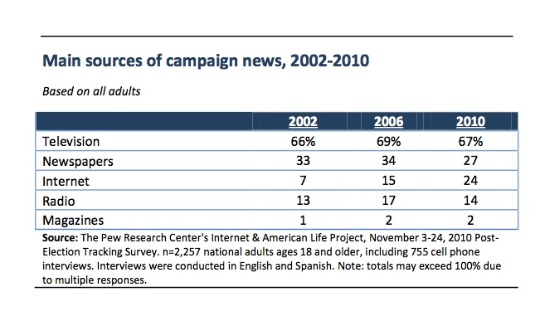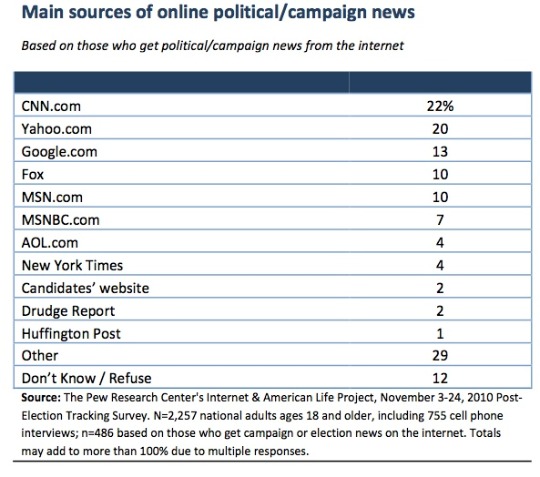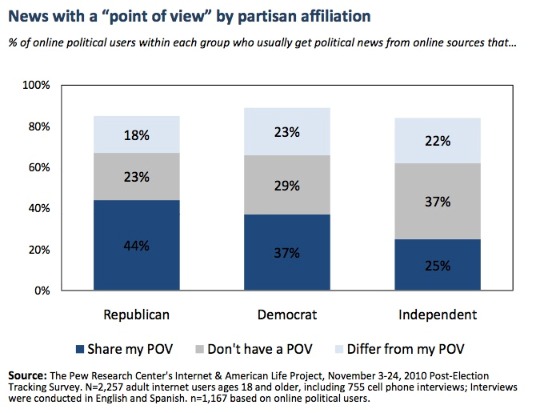Reading through comment streams during last year’s midterms, one often had to ask: Where are people getting their “information” from? Thanks to Pew, we now know.
Pew’s Internet and American Life Project released a new survey today titled “The Internet and Campaign 2010”. The study examines the way that American adults used the Internet during last year’s midterm campaigns. Its focus is on how adults used the web for “political purposes,” which include, under Pew’s definition: going online for political news, taking part in online political activities (like watching political videos), and using social networking tools for political reasons.
A quick conclusion: the web’s making big gains as a political news source, but TV’s still king. And, yep, we’re increasingly looking to have our political points of view affirmed rather than challenged. Oh, and we enjoy a good movie.
The headline results are interesting if unsurprising. According to Pew’s survey, 54 percent of American adults used the Internet for one or more of the above “political purposes” during last year’s midterms—more than did in 2006 or 2002. (Although, as survey author and Pew senior research analyst Aaron Smith points out, a direct comparison is difficult to make as the nature of web activity has changed significantly between the two midterm campaigns, and those that came before. Social networking, for example, had a much smaller online presence in 2006.)
In terms of political news, 58 percent of online adults looked online for news in 2010 and 32 percent of those online adults said they got most of their news from online sources. That’s up from 15 percent in 2006 and 7 percent in 2002. TV is still the dominant source for midterm news—let’s hear it for old media!—with 67 percent of survey respondents saying they get most of their political news from the tube. Among all adults, 24 percent said they got most of their news online—up from 7 percent in 2002. A round of applause for the new guys.

Local news shows dominated in terms of where people clicked to get their political TV news, with 33 percent saying they went to local stations (the same figure as 2006) to follow the campaign. Not surprisingly, Fox News ranked next—and, unsurprisingly again, played particularly well with Republicans—followed by NBC, CNN, ABC, CBS, MSNBC, and CNBC.
Online, CNN fared better in the survey, with CNN.com seemingly the number one go-to website for campaign news in the lead-up to the midterms—22 percent of respondents to an open-ended question about their online news sources mention that website. Here’s a full list of others who rated a mention:

What’s more interesting than where people went for their information, though, is why they went there. The survey reveals that among the 54 percent of adult Americans who engage politically online, just over a third (34 percent) were drawn to sources that “share their point of view.” That’s up from where the figure stood for 2008, 2006, and 2004, and slightly more than the 30 percent of people this year who said they tend toward sources that “don’t have a point of view.” There may be a connection between newer users swelling the percentage of people who are politically engaged online and the increase in those leaning on sources with which they are ideologically in sync.
If you’re looking to confirm some lefty suspicions, here’s Pew’s breakdown of the “point of view” figure by partisan affiliation:

There’s a whole lot of other interesting stuff to mine in Pew’s report—stats revealing that Internet users feel the Internet increases the impact of extreme views, and follow-up questions dividing respondents by their attitudes toward the Tea Party are of particularly noteworthy. As is the discovery that 56 percent of online adults say they find it difficult to determine truth from fiction among the political information that they find online—perhaps they need to stop heading to those POV-affirming sources. And 35 percent of online adults “fact-checking” candidates by tracking down their voting records and issue positions was a surprise.
Video was surprising, too. Among all Internet users, just 19 percent went online in the lead-up to the 2006 midterms to watch videos about candidates in the campaign. That figure jumped significantly to 31 percent in 2010. The biggest jump was among age groups over 30—and Republicans. Whether this increase was due to folks stroking their beards and nodding along to serious political news docs, or having a laugh to Christine O’Donnell’s Crucible-like witchcraft denials, is something, alas, Pew doesn’t tell us.
Joel Meares is a former CJR assistant editor.
